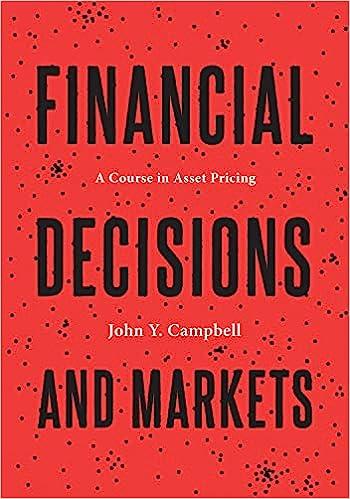Consider a static model in which a continuum of agents of unit mass with exponential (CARA) utility
Question:
Consider a static model in which a continuum of agents of unit mass with exponential (CARA) utility and coefficient of absolute risk aversion \(A\) invest their wealth in two risky assets (stocks) and a riskless asset. Stocks 1 and 2 have uncorrelated terminal payoffs \(v_{j}\) with common unconditional (prior) distribution \(\mathcal{N}\left(\mu_{0}, 1 / \tau_{0}ight)\). The quantities of these stocks supplied \(Z_{j}, j=1,2\), at the initial date are also random (observed imperfectly) and uncorrelated, with common distribution \(\mathcal{N}\left(\mu_{Z}, 1 / \tau_{Z}ight)\). The riskless asset, with return \(R_{f}\), is in perfectly elastic supply.
All agents observe a signal \(s_{1} \sim \mathcal{N}\left(v_{1}, 1 / \tau_{s}ight)\) for the payoff of stock 1 , corresponding to public information. Only a fraction \(\phi\) of agents observe a signal \(s_{2} \sim \mathcal{N}\left(v_{2}, 1 / \tau_{s}ight)\) for the payoff of stock 2, corresponding to private information. Signals are distributed independently from quantities supplied.
(a) Show that an agent's quantity demanded of each stock \(X_{j}, j=1\), 2, does not depend on the conditional distribution of the other stock's payoff.
(b) We first solve for the equilibrium price and returns in the market for stock 1.
(i) What is the agents' conditional payoff distribution and demand \(X_{1}\left(P_{1}, s_{1}ight)\) for stock 1?
(ii) Compute the equilibrium price \(P_{1}\left(s_{1}, Z_{1}ight)\) and unconditional expected excess return \(\mathrm{E}\left[v_{1}-\left(1+R_{f}ight) P_{1}ight]\).
(c) We now solve for the equilibrium in the market for stock 2, following the five steps for solving asymmetric information models discussed in section 12.1.2. Conjecture the pricing rule
![]()
(i) Derive the informed agents' conditional payoff distribution and demand \(X_{2}^{I}\left(P_{2}, s_{2}ight)\) for stock 2.
(ii) Derive the uninformed agents' conditional payoff distribution and demand \(X_{2}^{U}\left(P_{2}ight)\) for stock 2. How does their conditional variance for \(v_{2}\) depend on \(\tau_{s}\), \(\tau_{Z}, \phi\), and \(A\) ? Explain.
(iii) Impose market clearing to compute the equilibrium price \(P_{2}\left(s_{2}, Z_{2}ight)\) and the unconditional expected excess return \(\mathrm{E}\left[v_{2}-\left(1+R_{f}ight) P_{2}ight]\).
(d) Which stock commands a higher risk premium \(\mathrm{E}\left[v_{j}-\left(1+R_{f}ight) P_{j}ight]\) ? How does the risk premium for stock 2 depend on the fraction \(\phi\) of informed traders? Explain.
(e) Do the informed or uninformed hold more of stock 2 on average? Explain.
(f) Offer an explanation for home bias in portfolio choice based on this model. How might you test the model's predictions using data on domestic and foreign investors' portfolio composition and on equity premia across different countries?
Step by Step Answer:

Financial Decisions And Markets A Course In Asset Pricing
ISBN: 9780691160801
1st Edition
Authors: John Y. Campbell





